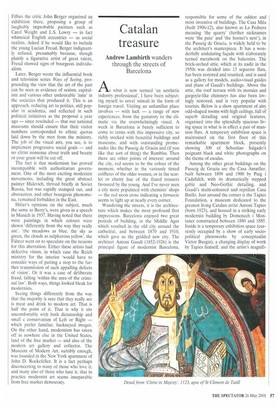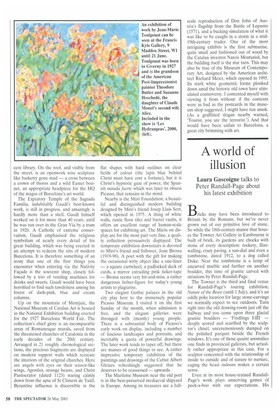Catalan treasure
Andrew Lambirth wanders through the streets of Barcelona
what is now termed 'an aesthetic industry professional', I have been subjecting myself to novel stimuli in the form of foreign travel. Visiting an unfamiliar place involves — with luck — a range of new experiences, from the gustatory to the climatic via the overwhelmingly visual. A week in Barcelona is barely sufficient to come to terms with this impressive city, so richly stocked with beautiful buildings and museums, and with outstanding promenades like the Passeig de Gracia and (if you like that sort of thing) the Ramblas. Then there are other points of interest: around the city, red seems to be the colour of the moment, whether in the variously tinted coiffures of the older women, or in the scarlet or cherry hue of the flared trousers favoured by the young. And I've never seen a city more populated with chemists' shops — the red neon cross indicating a farmacia seems to light up at nearly every corner.
Wandering the streets, it is the architecture which makes the most profound first impressions. Barcelona enjoyed two great periods of building, in the Middle Ages which resulted in the old city around the cathedral, and between 1870 and 1910, which gave us the gridded new city. The architect Antoni Gaudi (1852-1926) is the principal figure of modernist Barcelona, responsible for some of the oddest and most inventive of buildings. The Casa Mila (built 1906-12), also known as La Pedrera meaning 'the quarry' (further nicknames were 'the pate' and 'the hornet's nest'), in the Passeig de Gracia, is widely held to be the architect's masterpiece. It has a wonderfully undulating façade with elaborately turned metalwork on the balconies. The brick-arched attic, which at its nadir in the 1950s was divided into 13 separate flats, has been restored and reunited, and is used as a gallery for models, audio-visual guides and plans of Gaudi's buildings. Above the attic, the roof terrace with its mosaics and gargoyle-like chimneys has also been lovingly restored, and is very popular with tourists. Below is a show apartment of airy odd-shaped rooms with high ceilings, full of superb detailing and original features, organised into the splendidly spacious living space in what is in effect a pair of mansion flats. A temporary exhibition space is maintained on the first floor of this remarkable apartment block, presently showing 300 of Sebastiao Salgado's poignant black and white photographs on the theme of exodus.
Among the other great buildings on the Passeig de Gracia are the Casa Amatller, built between 1898 and 1900 by Puig i Cadafalch, with its dramatically stepped gable and Neo-Gothic detailing, and Gaudi's multi-coloured and reptilian Casa Ballo. Just around the corner is the Tapies Foundation, a museum dedicated to the greatest living Catalan artist Antoni Tapies (born 1923), and housed in a striking early modernist building by Domenech i Montaner constructed between 1880 and 1885. Inside is a temporary exhibition space (currently occupied by a show of early sociopolitical photoworks by conceptualist Victor Burgin), a changing display of work by Tapies himself, and the artist's magnifi cent library. On the roof, and visible from the street, is an openwork wire sculpture like basketry gone mad — a cross between a crown of thorns and a wild Easter bonnet, an appropriate headpiece for the HQ of the magus of Barcelona's art world.
The Expiatory Temple of the Sagrada Familia, indubitably Gaudi's best-known work, is still in progress, and amazingly is hardly more than a shell. Gaudi himself worked on it for more than 40 years, until he was run over in the Gran Via by a tram in 1926. A Catholic of extreme conservatism, Gaudi emphasised the religious symbolism of nearly every detail of his great building, which was being erected in an attempt to redeem the sins of modern Barcelona. It is therefore something of an irony that one of the first things you encounter when entering via the Nativity Façade is the souvenir shop, closely followed by a trio of vending machines for drinks and sweets. Gaudi would have been horrified to find such tawdriness among his forest of dark-pink, blue and cream columns.
Up on the mountain of Montjuic, the National Museum of Catalan Art is housed in the National Exhibition building erected for the 1927 Barcelona World Fair. The collection's chief glory is an incomparable array of Romanesque murals, saved from the threatened churches of Catalonia in the early decades of the 20th century. Arranged in 21 roughly chronological sections, the precious fragments are displayed on modern support walls which recreate the interiors of the original churches. Here are angels with eyes on their scissor-like wings, Apostles, strange beasts, and Christ Pantocrator (dated 1123) staring calmly down from the apse of St Climent de Taal Byzantine influence is discernible in the flat shapes with hard outlines on clear fields of colour (the lapis blue behind Christ must have cost a fortune), but it is Christ's hypnotic gaze of power, the Spanish mirada fuerte which was later to obsess Picasso, that remains in the mind.
Nearby is the Miro Foundation, a beautiful and distinguished modern building designed by Miro's friend Josep Lluis Sert, which opened in 1975. A thing of white walls, rustic floor tiles and barrel vaults, it offers an excellent range of human-scale spaces for exhibiting art. The Minos on display are for the most part very fine, a quality collection persuasively displayed. The temporary exhibition downstairs is devoted to Mini's friend and follower, Joan Brossa (1919-98). A poet with the gift for making the occasional witty object like a one-liner — a square cartwheel, a padlocked deck of cards, a mirror extruding pink ticker-tape — Brossa seems very hit-and-miss, a rather dangerous father-figure for today's young artists to plagiarise.
Two elegant Gothic palaces in the old city play host to the immensely popular Picasso Museum. I visited it on the first Sunday of the month, when admission is free, and the elegant galleries were thronged with (mostly) young people. There is a substantial body of Picasso's early work on display, including a number of luscious landscapes and portraits, and inevitably a quota of powerful drawings. The later work tends to taper off, but there are masses of good things to see. A rather impressive temporary exhibition of the paintings and drawings of the Cubist Albert Gleizes refreshingly suggested that he deserves to be reassessed — upwards.
The Maritime Museum near the old port is in the best-preserved mediaeval shipyard in Europe. Among its treasures are a full
scale reproduction of Don John of Austria's flagship from the Battle of Lepanto (1571), and a bucking simulation of what it was like to be caught in a storm in a mid19th-century trader. One of the most intriguing exhibits is the first submarine, quite small and fashioned out of wood by the Catalan inventor Narcis Monturiol, but the building itself is the star turn. This may also be true of the Museum of Contemporary Art, designed by the American architect Richard Meier, which opened in 1995. Its stark white geometric forms plonked down amid the historic old town have stimulated controversy. I contented myself with viewing it from without: if the contents were as bad as the postcards in the museum shop suggested, I might have run amok. (As a graffitied slogan nearby warned, 'Tourist, you are the terrorist.') And that would have been unfair to Barcelona, a great city brimming with art.



















































































 Previous page
Previous page